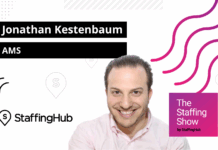
The same artificial intelligence driving mass layoffs across industries is creating a talent war so fierce that traditional peer groups, competitive intelligence, and compensation benchmarks have become virtually obsolete overnight. AI is not just changing how we hire, but who we compete for and what candidates value most.
AI-driven market dynamics
U.S.-based employers announced 62,075 job cuts in July, up 29% from June’s 47,999, with technology leading private sector reductions. This same technological disruption is driving fierce competition for AI talent, where adding AI skills to job descriptions could cost employers 28% more in annual compensation, according to research from Lightcast.
And this isn’t only a tech industry phenomenon. More than half (51%) of the AI roles in Lightcast’s analysis were not in tech-related industries, up from 44% in 2022, signaling that AI expertise has become a cross-industry imperative. For staffing agencies, this means traditional industry boundaries are blurring, and client competition for talent extends far beyond expected peer groups.
Job candidates don’t want to get left behind
Gen Z workers are driving a change in hiring expectations, with more than half (52%) prioritizing “growth mindset” roles that offer personal development opportunities. This generation is also 68% more likely to prioritize learning and development benefits — such as language lessons, mentor programs, and study leave — when seeking new jobs, compared to just a third of millennials, Generation X, and baby boomers.
This shift may be a response to AI’s impact on entry-level work. “With AI taking on the burden of low-level, repetitive tasks,” says Molly Johnson-Jones, co-founder and CEO of Flexa, “the nature of roles available to job seekers entering the workforce for the first time is changing.”
A human-AI hybrid approach can win placements
As AI reshapes talent acquisition, updated approaches will help staffing agencies remain effective partners for their clients. Here are five strategies to address these significant changes in candidate expectations, market competition, and hiring processes.
1. Redefine your competitive intelligence
Traditional peer group analysis is insufficient in the AI talent wars. Organizations are looking not only to these firms, but also “some of the largest, most famous, private AI companies” to pull AI talent from. Staffing agencies should consider expanding their market intelligence to include AI-focused companies and tech giants, even when serving clients in traditionally non-technical industries.
2. Embrace technology-enhanced assessment
The debate over personality testing versus AI-driven recruitment tools presents a false dichotomy. The most obvious benefit of using personality tests during the hiring process in a world of AI is to use the technology to enhance the analysis. Agencies can leverage AI to identify subtle patterns while maintaining human oversight for cultural fit and emotional intelligence assessment.
Machine learning algorithms can also detect inconsistencies in responses, adjust for cultural biases, and analyse the linguistic patterns in open-ended questions to provide richer personality profiles. This approach provides competitive advantage while addressing AI’s limitations in understanding the subjective, contextual nature of human personality.
3. Develop specialized AI talent pipelines
The supply-demand imbalance for AI skills requires proactive pipeline development. Though employer demand for AI expertise continues to grow rapidly, the available talent pool has remained relatively static, creating significant market tension. It may be worth investing in relationships with universities, bootcamps, and certification programs to identify emerging talent before they hit the broader market.
4. Create value beyond compensation
While AI roles command premium salaries, not every client can compete on compensation alone. Equity packages, flexible work arrangements, and opportunities to tackle challenging, innovative projects can be equally compelling to top-tier candidates, especially when base salary competition becomes prohibitive. Agencies can help clients articulate their unique value proposition beyond monetary compensation.
5. Focus on learning and development
Flexa reported a 240% increase in the number of job searches for roles offering learning and development benefits since the start of 2025 — across all age groups. Consider counseling clients on incorporating robust learning opportunities into job descriptions and actively promote roles that offer skill development pathways.
Implementation steps
Immediate actions:
- Audit your current assessment tools and integrate AI-enhanced capabilities
- Expand competitive intelligence to include AI-focused companies
- Train recruiters on identifying and articulating learning and development opportunities
Medium-term strategy:
- Develop specialized teams for AI talent acquisition
- Create partnerships with educational institutions and training providers
- Implement technology that can detect and highlight transferable AI skills in candidate profiles
Long-term planning:
- Build predictive models to anticipate AI skill demand across industries
- Develop proprietary tools that combine personality assessment with AI-driven analytics
- Create talent development programs in partnership with clients
The AI revolution in hiring is already here. AI drove more than 10,000 job cuts just last month, while simultaneously creating premium demand for AI-skilled professionals. Staffing agencies can adapt to this landscape by balancing technological capabilities with human insight, understanding generational shifts in candidate priorities, and developing sophisticated approaches to talent intelligence.
The key is not to choose between human expertise and AI capabilities, but to strategically combine both in service of better hiring outcomes.





